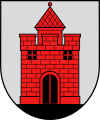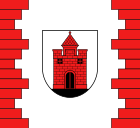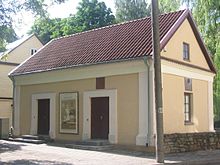Panevėžys
| Panevėžys | |||
|
|||
| State : |
|
||
| District : | Panevėžys | ||
| Municipality : | Panevėžys | ||
| Founded : | 1503 | ||
| Coordinates : | 55 ° 44 ′ N , 24 ° 22 ′ E | ||
| Height : | 50 m | ||
| Area (place) : | 50 km² | ||
| Inhabitants (place) : | 124,412 (2018) | ||
| Population density : | 2,488 inhabitants per km² | ||
| Time zone : | EET (UTC + 2) | ||
| Telephone code : | (+370) 45 | ||
| Postal code : | 352xx | ||
| Status: | Borough | ||
| Mayor : |
Vitalijus Satkevičius ( Tėvynės Sąjunga - Lietuvos krikščionys demokratai ) |
||
| Website : | |||
|
|
|||
Panevėžys ( ; German: Ponewiesch; Polish : Poniewież; Yiddish פּאָנעװעזש, the transcription of which is Ponevezh ) is a large city in northern Lithuania with 124,412 inhabitants, around 130 kilometers from the two capitals Riga ( Latvia ) and Vilnius (Lithuania ) away. Panevėžys is the capital of the Panevėžys district of the same name , an administrative district in northeastern Lithuania, which is part of the historical landscape of Upper Lithuania . It has the status of a township , so it has an elected mayor and city council. It is surrounded by the Panevėžys Rajonggemeinde, of which it is the administrative seat. As the fifth largest city in the country, Panevėžys is the smallest large city in Lithuania. The name Panevėžys means "located on the bank of the Nevėžis River".
history
On September 7, 1503, Panevėžys was first mentioned in a letter from Grand Duke Alexander of Lithuania to the Bishop of Ramgyla. With this letter, the Grand Duke made the clergyman the owner of the lands around the Panevėžys estate, located between the Nevėžis and Lėvuo rivers . The condition for this was the erection of a church, whereby this wooden church has since been destroyed. For the 500th birthday of Panevėžys in 2003, a monument to Grand Duke Alexander was erected. Groups of Poles and Karaites settled the area as early as the 14th century.
Not far from the Panevėžys manor, the Mikolajevas settlement was founded in the 16th century, and the Naujasis (New) Panevėžys settlement was established on the other side of the river. In the 19th century these three places were united to form the town of Panevėžys. In 1813 Panevėžys were granted city rights. Up to the middle of the 19th century, almost all buildings in the city were built using wood, although these buildings were destroyed in the First World War , when almost the entire city burned down. In the age of increasing industrialization , Panevėžys also gained importance as a banking and trading center. In 1927 the city also became the seat of the Panevėžys diocese .
On June 15, 1940, the Russian military took control of the city in the course of the forced integration of Lithuania into the Soviet Union . During the Russian occupation, a large number of political prisoners were murdered in the vicinity of the sugar factory, and an even greater number of citizens were either deported to Siberia or persecuted in some other way.
After the German attack on the Soviet Union , Panevėžys was occupied by German troops, as was the case in World War I, and became a regional commissioner within the Reich Commissioner for Ostland . During the time of occupation by the German troops, the city's Jewish population was almost completely murdered: over 10,000 people as early as July and August 1941. In the process, "Einsatzkommando 3" under the leadership of Karl Jäger ( Einsatzgruppe A ) fell victim to 1,312 Jewish men, 4602 women and 1609 children on August 23, 1941 alone. When the German troops withdrew, the city was also badly damaged. After the end of the war, the Soviet leadership relied on the city's increasing industrialization. Many large companies were founded in the 1960s and 1980s in particular. Thanks to its convenient location and the construction of the railway, Panevėžys developed more and more into an industrial center. Due to the increasing demand for housing among workers, many prefabricated buildings were built , especially in the 1960s .
Politics and administration
Panevėžys has been a municipality since 1995 (lit. Panevėžio miesto savivaldybė ). The representative body is the City Council, which consists of 31 members. The executive power is exercised by the Panevėžys Municipality Administration ( Panevėžio miesto savivaldybės administracija ).
mayor
- 1995–1997: Tomas Josas
- 1997–2000, 2003–2007, 2007–2008: Vitas Matuzas
- 2000–2002: Valdemaras Jakštas
- 2002–2003: Visvaldas Matkevičius
- 2008–2010 and 2011: Povilas Vadopalas
- 2010–2015: Vitalijus Satkevičius (* 1961), TS-LKD
- since 2015: Rytis Mykolas Račkauskas (* 1959), non-party
Vice Mayor
- Since 2015
- Petras Luomanas (* 1948), TS-LKD
- Aleksas Varna (* 1948), VRK "Mums svarbu"
- Until 2015
- Regina Eitmonė (* 1961)
- Maurikijus Grėbliūnas (* 1966)
Attractions
In contrast to other Lithuanian inner cities such as B. Vilnius and Kaunas, where medieval or baroque buildings dominate, shape the cityscape in Panevėžy's architecture from the 19th and 20th centuries. Examples of this are the grammar school, which was the first national school to teach Lithuanian in 1915, and one of the oldest bookshops in Lithuania from 1905.
In the center of the city, in the immediate vicinity of the Panevėžys bus station, is the Freedom Square ( Laisvės aikštė ), around which several shops and cafes are grouped. The town hall and the J. Miltinis Theater are also located here.
To the north of the Freiheitsplatz is the old river bed, which has been dammed into a large pond with a fountain and islets. Along the new river bed, promenades were built on which some sculptures stand.
The history of St. Peter and Paul Church goes back to the wooden church originally built by the Bishop of Ramgyla when the city was founded. Over the centuries, the location was relocated and new buildings were built several times. The current building is a baroque building completed in 1804.
The Episcopal Christ the King Cathedral was built in the neo-baroque style between 1908 and 1929 and consecrated by Maironis. Above the altar is a very large painting depicting a victorious Lithuanian army in the Middle Ages.
economy
Ekranas , a manufacturer of television tubes and flat screens with 4200 employees, as well as the Kalnapilio-Tauro grupė brewery , which belongs to the Danish Royal Unibrew brewery group, were among the largest industrial companies in the area.
Other important companies are “Techasas Trade”, “Linas” (a manufacturer of linen products) and the construction company “ Panevėžio statybos trestas ”.
Amilina
Amilina operates a wet wheat mill and processes wheat into starch and vital gluten fractions. The turnover in 2013 was around 106 million euros.
Ekranas
"Ekranas" was founded in the Soviet era and privatized in 1994. The company became Akcinė bendrovė (joint stock company). The main activity was the manufacture of electronic devices. The company was listed on the Vilnius Stock Exchange.
PST
In 2010 the company generated sales of 170 million euros. It has 1080 employees.
Panevėžys Forestry Office
Panevėžys Forestry Service (Panevėžio miškų urėdija) is a state-owned enterprise (Valstybės įmonė). It is active in forest management and forest protection .
Free economic zone
The Panevėžys Free Economic Zone exists as a special economic zone to facilitate investment .
traffic
Panevėžys is connected to Kaunas and Riga by the Via Baltica . After Vilnius a highway leads. The main road Palanga-Šiauliai-Kupiškis to Daugavpils in Latvia runs in a west-east direction . The rail connection from Kaliningrad via Klaipėda to Panevėžys runs in the same direction . From here the route continues via Rokiškis and Daugavpils towards Moscow . There is no direct train connection to Vilnius - you have to change trains in Radviliškis . In addition, there is the Upper Lithuanian Narrow Gauge Railway (Aukštaitijos siaurasis Gelezinkelis) with a gauge of 750 mm, which has existed since 1899. Today it no longer runs regularly, but is still used for tourism. It connects the Panevėžys station via Anykščiai with Rubikiai over a distance of 69 km . The rest of the route to Utena is closed .
Six kilometers east of Panevėžys is the former Panevėžys military airfield , also known as Pajuostis ( ICAO : EYPP).
For cyclists, the city of Panevėžys has attempted to designate a cycle path in an east-west direction across the city.
In the city center, Panevėžys has 13 bus routes, the entire route network being 136.8 kilometers long and having 223 stops.
Culture
- theatre
- The Juozas Miltinis drama theater has long enjoyed a republic-wide and even international reputation.
- The Panevėžys Puppet Theater regularly performs its performances on a horse-drawn vehicle during the summer.
- In front of the Menas Theater, founded in 1991, there is a sculpture of the character Don Quixote
- Musical theater
- Museums
- The Landeskundemuseum houses archaeological finds and a collection of 5000 butterflies
- The photo gallery hosts around 30 exhibitions per year
- The art gallery also offers around 25 exhibitions a year
- In the court archive, the oldest preserved building in the city from 1614, there is an exhibition that shows paintings, historical documents and wooden sculptures.
- In the Sports Museum, exhibits on the history of sports in the Panevėžys region are shown.
In 2014 Panevėžys was the cultural capital of Lithuania .
education
General education schools
- Juozas Balčikonis High School Panevėžys
- Vytautas Žemkalnis High School Panevėžys
- 5. Panevėžys grammar school
Special education
- Panevėžys boarding school
- Vytautas Mikalauskas Art School Panevėžys
- Panevėžys Nature School
- Panevėžys Vocational Training Center
Colleges
- Panevėžys College
- Faculty of Economics, Kaunas University of Technology
Higher schools
There used to be these schools:
Sports
Ekranas Panevėžys is the city's most important football club.
Since 2008 the city has had the multifunctional Cido-Arena, in which sporting events and concerts take place. In 2011, games of the 2011 European Basketball Championship were played there. The Arena has a 250-meter velodrome by the UCI standard . The train was designed by the Münster architect Ralph Schürmann . The European Railway Championships took place there in November 2012 .
Judiciary
- Panevėžys District Court
- Panevėžys District Court
- Panevėžys District Administrative Court
- Panevėžys Higher District Police Department
- Panevėžys District Police Department
- Panevėžys Higher District Police Department
- Panevėžys Public Prosecutor's Office
- Panevėžys District Prosecutor's Office
Town twinning
Panevėžys lists twelve twin cities and regions:
| city | country | since |
|---|---|---|
| Toyohashi |
|
2019 |
| Daugavpils |
|
2004 |
| Gabrovo |
|
2004 |
| Goes |
|
1993 |
| Kaliningrad |
|
2002 |
| Squid |
|
1992 |
| Kolding |
|
2000 |
| Lublin |
|
1999 |
| Luenen |
|
1990 |
| Mytishchi |
|
2001 |
| Rakvere |
|
2005 |
| Rustavi |
|
|
| Vinnytsia |
|
2015 |
| Maramureș County |
|
2015 |
sons and daughters of the town
- Maria Lvovna Dillon (1858–1932), Russian sculptor
- Alexander Lebedew (1893–1969), Lithuanian-Russian physicist and university professor
- Gideon Mer (1894–1961), Israeli scientist of Lithuanian-Russian origin
- Teisutis Zikaras (1922–1991), Lithuanian-Australian sculptor
- Kostas Birulis (1925–2004), radio engineer and politician
- Zygmunt Ławrynowicz (1925–1987), Polish poet
- Mykolas Sluckis (1928-2013), writer
- Vytautas Mikalauskas (1930-2004), composer and pianist
- Algimantas Čekuolis (* 1931), journalist, publicist and travel guide
- Antanas Janauskas (1937–2016), animator and film director
- Algirdas Jurkauskas (* 1937), engineer and professor
- Arvydas Šliogeris (* 1944), philosopher
- Saulius Varnas (* 1948), actor and director
- Egidijus Bieliūnas (* 1950), lawyer, criminal lawyer and judge
- Jonas Kazlauskas (* 1954), basketball player and coach
- Rimantas Liepa (* 1954), politician
- Vidmantas Urbonas (* 1958), extreme athlete
- Gediminas Kazlauskas (* 1959), manager, civil engineer, politician and environment minister (2008–2012)
- Romas Ubartas (* 1960), athlete
- Artūras Melianas (* 1964), politician
- Algis Vaičeliūnas (* 1964), general and commander of BALTDEFCOL
- Kęstutis Skrebys (* 1965), politician
- Aurelija Stancikienė (* 1966), politician
- Virginijus Baltušnikas (1968), Soviet-Lithuanian football player
- Rolandas Kriščiūnas (* 1970), diplomat, ambassador and politician
- Jolanta Polikevičiūtė (* 1970), racing cyclist
- Rasa Polikevičiūtė (* 1970), cyclist
- Liudas Mockūnas (* 1976), musician
- Dagnė Čiukšytė (* 1977), chess player
- Raimondas Vilčinskas (* 1977), racing cyclist
- Živilė Šarakauskienė (* 1978), chess player
- Mindaugas Lukauskis (* 1979), basketball player
- Augustas Strazdas (* 1980), handball player
- Aurimas Kučys (* 1981), football player
- Domas Petrulis (* 1981), politician
- Arūnas Klimavičius (* 1982), football player
- Edgaras Česnauskis (* 1984), football player
- Vesta Kasputė (* 1984), chess player and business lawyer
- Andrius Buividas (* 1985), track and road cyclist
- Greta Kildišienė (* 1985), politician
- Ignatas Konovalovas (* 1985), racing cyclist
- Vilija Sereikaitė (* 1987), cyclist
- Aušrinė Trebaitė (* 1988), cyclist
- Vytautas Černiauskas (* 1989), football player
- Linas Klimavičius (* 1989), football player
- Danas Rapšys (* 1995), swimmer
- Vasilijus Lendel (* 1995), cyclist
- Miglė Marozaitė (* 1996), cyclist
- Olivija Baleišytė (* 1998), cyclist
Climate table
| Panevėžys | ||||||||||||||||||||||||||||||||||||||||||||||||
|---|---|---|---|---|---|---|---|---|---|---|---|---|---|---|---|---|---|---|---|---|---|---|---|---|---|---|---|---|---|---|---|---|---|---|---|---|---|---|---|---|---|---|---|---|---|---|---|---|
| Climate diagram | ||||||||||||||||||||||||||||||||||||||||||||||||
| ||||||||||||||||||||||||||||||||||||||||||||||||
|
Average monthly temperatures and rainfall for Panevėžys
|
|||||||||||||||||||||||||||||||||||||||||||||||||||||||||||||||||||||||||||||||||||||||||||||||||||||||||
literature
- Panevėžys , in: Guy Miron (ed.): The Yad Vashem encyclopedia of the ghettos during the Holocaust . Jerusalem: Yad Vashem, 2009 ISBN 978-965-308-345-5 , pp. 573f.
Web links
- Panevėžy's Official City Website
Individual evidence
- ↑ Population figures from Eurostat , estimated (2018), accessed June 22, 2020
- ^ Homepage of the City of Panevėžys, accessed on August 15, 2010.
- ↑ Unless otherwise stated, the presentation of the history and the sights is based on: Claudia Marrenbach, Gaby Coldewey, Sybille Heeg, Gertrud Ranner: Baltic countries, Latvia, Lithuania, Estonia, Michael Müller Verlag, Erlangen, 5th edition, 2008, p . 181 ff., ISBN 3-89953-380-1 and Günther Schäfer: Lithuania with Kaliningrad, Reise Know-How Verlag Peter Rump GmbH, Bielefeld, 4th edition, 2003, p. 337 ff., ISBN 3-8317-1152 -6 .
- ↑ see also: Kenessa Panevėžys
- ↑ See Wolfram Wette: Karl Jäger. Murderer of the Lithuanian Jews, Frankfurt, Fischer 2011. See also Jäger report .
- ↑ Information from the Lithuania network website, accessed on August 15, 2010.
- ↑ Information on the story on the Panevėžys City website, accessed on August 15, 2010
- ↑ Howard Jarvis, John Oates, Tim Ochser, Neil Taylor: Baltikum, Estonia, Latvia and Lithuania, Dorling Kindersley, Munich 2009, p. 264.
- ↑ Information from the Ekranas website, accessed on August 16, 2010 ( Memento of the original from June 12, 2009 in the Internet Archive ) Info: The archive link has been inserted automatically and has not yet been checked. Please check the original and archive link according to the instructions and then remove this notice.
- ↑ Website of the construction company Statybos Trestas, ( Memento of the original from January 2, 2011 in the Internet Archive ) Info: The archive link was inserted automatically and has not yet been checked. Please check the original and archive link according to the instructions and then remove this notice. Retrieved August 16, 2010.
- ↑ Forestry Office
- ↑ Description of Panevėžys Airport at fallingrain.com, accessed on August 15, 2010.
- ↑ Information on the Panevėžio autobusų parkas bus company in Wikipedia, accessed on August 15, 2010.
- ↑ Information from the Litauen.info portal, accessed on August 15, 2010.
- ↑ cidoarena.lt
- ↑ Panevežio miesto savivaldybe - Miestai partneriai - website of the City of Panevėžys . Retrieved August 6, 2017.








